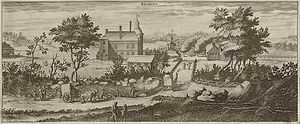Barbro Eriksdotter (Bielke)
Barbro Eriksdotter (Bielke) (died 1553), known in history as Barbro Påle (In English: "Barbara Stake") was a Swedish noble and land lord. She has a significant place within Swedish folklore, where she is known in a legendary ghost story, and is also believed to be the probable historical person behind the legend of pintorpafrun, a known figure representing a stereotype of a cruel lady of the manor who tortures and mistreats her subordinates. She was by her contemporaries known for her cruelty toward her tenants and rumoured to be a witch. Another person pointed out as the historical person behind pintorpafrun is Anna Karlsdotter (Vinstorpa).
Background
Barbro was born to the noble councillor of state Erik Turesson (Bielke) and Gunilla Johansdotter Bese: among her siblings were riksråd and governor Axel Eriksson (Bielke), riksrådTure Eriksson (Bielke) and the defender of Kalmar, Anna Eriksdotter (Bielke). She was married to her sisters stepson, riksråd knight Måns Johansson Natt och dag (1500–1555) in Stockholm in 26 June 1524. By marriage, she took the responsibility of her husband's estate, Brokind Castle in Östergötland.
Land lord

Barbro became infamous for her treatment of the tenants under the manor: she was described as a cruel and hard mistress who enjoyed tormenting her subordinants. She was also pointed out as a witch who could master magic. Legend say, that she had people chained up in the private dungeons of the manor, called the "tjuvakistan" (In English:" The coffin of thieves") for the smallest mistakes. To torment the starved prisoners, she had a table filled with food and drink set up in front of them, just out of their reach. When the public complained at the starvation of the prisoners, she is said to have laughed and answered them:
"They have both food and drink by their side ; if they will not eat, they can blame themselwes. "
The prison at Brokind manor became widely known, and the place where the prison was is today still known as "Kisthagen" (In English: "Coffin meadow")
In folklore
Barbro is the subject of a well-known old ghost story. She was buried in the ancestral tomb of her family in Linköpings domkyrka, but according to legend she did not rest peacefully in her grave, but haunted the cathedral. Her coffin was therefore moved to the parish church at Brokind, Vårdnäs kyrka, but now, she haunted her new burial ground instead. According to legend, a stake was thereafter forced through her body to make it lay in peace. By this, she became known as Barbro Påle; Barbara Stake. In some versions, her pierced body was afterward thrown in the lake Tarmsjön at Brokind manor. After this, it is said that people have heard a cry from the lake saying: Barbara stake, Barbara stake, the spirit could go no further... Legend say that at late nights, Barbro can be seen dancing with Satan at Brokind Manor.
Image
- http://www.edu.linkoping.se/satra/hembygdsboken/barbropale/barbropale.htm (Fictional image of the legendary Barbro Påle)